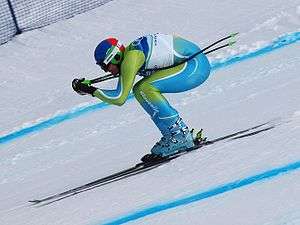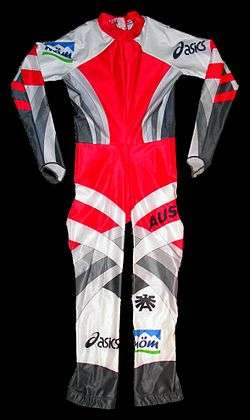Downhill (ski competition)

Downhill is a form of alpine skiing competition. Whereas other alpine skiing events, slalom, giant slalom, super giant slalom, and combined emphasize turning and technique, downhill emphasizes "the six components of technique, courage, speed, risk, physical condition and judgement", according to the FIS "International Ski Competition Rules (ICR)".[1] Speeds of up to 130 km/h (81 mph) are common in international competition. Athletes must have an aerodynamically efficient tuck position to minimize drag and increase speed.[2]
The term, "downhill skiing", is also used as a synonym for alpine skiing as a recreational activity.[3][4]
History
The rules for downhill skiing competitions were originally developed by Sir Arnold Lunn for the 1921 British National Ski Championships. A speed of 100 miles per hour (161 km/h) was first achieved by Johan Clarey at the 2013 Lauberhorn World Cup,[5] beating the previous record of 98 mph (158 km/h), set by Italian Stefan Thanei in 2005.[6][7]
Course
The FIS has rules for downhill courses that encompass their general characteristics, width, safety precautions, vertical drop, course length, style and placement of gates.[1]
- General characteristics – As a test of "technique, courage, speed, risk, physical condition and judgement", the course requires the athlete to adapt to the technically demanding terrain and layout of gates.
- Width – Courses are typically 30 metres (100 ft) wide with allowances for the approaches to "lips, drop-offs and jumps".
- Safety – Obstacles on courses are expected to be protected with nets, fences, or pads.
- Vertical drop – Vertical drop ranges from 450 to 1,100 metres (1,480 to 3,610 ft) for men and 450 to 800 metres (1,480 to 2,620 ft) for women. Races with two runs may be shorter.
- Course length – Courses require an accurate means of measurement for length.
- Gates – Gates consist of pairs of twin poles with a rectangular panel between the poles. Gates have an 8-metre (26 ft) or larger opening.
Equipment

Equipment for the Downhill is different from the alpine events that are lower-speed. Skis are 30% longer than those used in slalom, for more stability at high speed. They usually have rounded, low-profile tips rather than pointed tips. Ski poles are bent so as to curve around the body as the racer stays in a "tuck position" and may have aerodynamic, cone-shaped baskets. As in other alpine disciplines, Downhill racers wear skin-tight suits to minimize drag, and helmets are mandatory.
In an attempt to increase safety, the 2003-2004 season saw the FIS increase the minimum sidecut radius for Downhill skis to 45 metres (148 ft) from 40 metres (131 ft), and impose minimum ski lengths for the first time: 218 cm (7 ft 2 in) for men, and 210 cm (6 ft 11 in) for women.
Races
In all forms of Downhill, both at a local youth-level as well as the higher FIS international level, racers are allowed extensive preparation for the race, which includes daily course inspection and discussion with their coaches and teammates as well as several practice runs before the actual race. Racers do not make any unnecessary turns while on the course, and try to do everything they can to maintain the most aerodynamic position while negotiating turns and jumps.
Unlike Slalom and Giant Slalom, where racers have the times of two runs combined, the Downhill race is a single run. Times are typically between 1½ and 2½ minutes for World Cup courses and must be over 1 minute in duration to meet international minimum standards. Tenths and hundredths and, occasionally, thousandths of seconds count: World Cup races and Olympic medals have sometimes been decided by as little as one or two hundredths of a second, and ties are not unheard of.
The most successful all-time winners of World Cup Downhill races are Annemarie Moser-Pröll of Austria (36 wins, 7 women's titles)[8] and Franz Klammer of Austria (25 wins, 5 men's titles).[9] Lindsey Vonn of the U.S. is currently dominant in woman's downhill racing with a lifetime total of 37 World Cup downhill wins and 7 women's titles.[10][11]
Risks
On some courses, such as the Lauberhorn course in Wengen, Switzerland, and the Hahnenkamm course in Kitzbühel, Austria, speeds of up to 150 km/h (93 mph) are common. Safety netting and padding are placed where race officials anticipate crashes. Despite these safety precautions, the ski racing community is well aware of the inherent risks of Downhill skiing, for it is possible for racers to suffer serious injury or death while practising or competing. Three deaths among World Cup racers in recent years in downhill training or during a race were those of Austrians Gernot Reinstadler (1991) and Ulrike Maier (1994) and France's Régine Cavagnoud (2001). Also in 2001, Swiss downhiller Silvano Beltrametti was paralyzed in a high-speed crash and 1984 Olympic gold medalist Bill Johnson suffered permanent brain damage that eventually led to a crippling stroke which left him unable to function without assistance. Most recently Frenchman David Poisson was killed in a training crash in 2017. Speaking to media after Poisson's death, French former downhiller Luc Alphand noted that "eliminating risk entirely in downhill is impossible".[12]
Men's World Cup podiums
In the following table men's downhill World Cup podium results in the World Cup since the first season in 1967.[7] Winners receive a distinctive crystal globe.[13]
See also
- List of men's World Cup Downhill title winners
- List of women's World Cup Downhill title winners
- List of Olympic medalists in men's Downhill
- List of Olympic medalists in women's Downhill
- List of Paralympic medalists in men's Downhill
- List of Paralympic medalists in women's Downhill
- List of World Champions in Downhill
- List of men's downhill races in the FIS Alpine Ski World Cup
References
- 1 2 50th International Ski Congress (July 2016), The International Ski Competition Rules (ICR) (PDF), Cancun: Fédération Internationale de Ski (FIS), p. 83 .
- ↑ First Tracks!! Online Ski Magazine (October 11, 2011). Canadian Ski Racers Train in Wind Tunnel.
- ↑
Editors (2017). "Cambridge Dictionary". Cambridge.org. Cambridge University Press. Retrieved 2017-02-16.
skiing down slopes, rather than along level ground
- ↑
Editors (2017). "Merriam-Webster Dictionary". Merriam-Webster.com. Merriam-Webster, Incorporated. Retrieved 2017-02-16.
a: the sport of skiing on downhill trails—often used attributively. b: a skiing race against time down a trail
- ↑ "French skier sets speed record of 100 mph in downhill". USA Today. Associated Press. January 19, 2013. Retrieved January 8, 2018.
- ↑ "Wengen Downhill World Cup Race - Lauberhorn - SnowKings". www.snowkings.co.uk.
- 1 2 "Downhill - Top ten racers since 1967". prussianmachine.com. Retrieved 9 February 2018.
- ↑ International Ski Federation (FIS). Biography: Annemarie Moser-Pröll. FIS Legends. Retrieved on: 2011-12-27.
- ↑ International Ski Federation (FIS). Biography: Franz Klammer. FIS Legends. Retrieved on: 2011-12-27.
- ↑ International Ski Federation (FIS). Biography: Lindsey Vonn. FIS Legends. Retrieved on: 2011-12-27.
- ↑ The Australian (December 05, 2011). Lindsey Vonn wins 23rd World Cup downhill in Canada. Retrieved on: 2011-12-27.
- ↑ "French downhill skier David Poisson dies after training crash at Nakiska". CBC.ca. 13 November 2017. Retrieved 25 February 2018.
- ↑ International Ski Foundation. "FIS World Cup Trophy" (PDF). www.fis-ski.com. International Ski Federation. Retrieved 2018-02-10.
The FIS World Cup trophy is a trophy manufactured solely for the International Ski Federation. The trophy, unique in terms of the glass refining techniques used, is exclusively awarded to the FIS World Cup winners of each discipline at the Season Finals.